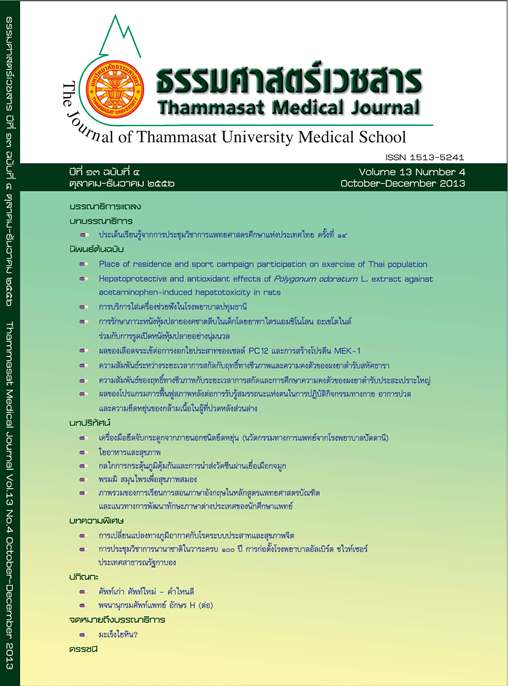Hearing aid fitting procedure in the Pathumthani hospital
Keywords:
Hearing impairment, Hearing aid, Presbycusis, Hearing loss applicantsAbstract
Introduction: Hearing impairment is a common health problem that has an adverse effect on physical, emotional, socialand economic aspects. Thailand entered into the period of aging society in 2010. The incidence of hearingimpairment increases with age. There is likely a large need for hearing rehabilization by means ofhearing aid. A primary obstacle to hearing aid provision is their high cost. Since 2010, the hearing impairedpersons have been eligible the hearing handicap that obtained complementary hearing aid available inthe national health security system. This study aimed to evaluate hearing aid fitting procedure atPathumthani Hospital in The National Health Security System.
Method: This study was prospective cohort descriptive study. The hearing-impaired patients who had pure tone air-conductionaverage hearing loss in the better ear of 40 dB or more for 500, 1,000, 2,000 Hz which was the cuttingpoint for handicap and they possessed of hearing aid. They were fitted with the digital hearing aid andhad been followed up at Pathumthani Hospital from March 2010 to December 2012.
Result: Three hundred and thirty-four hearing-impaired patients were fitted the digital hearing aid, 281 patientswere adult onset hearing loss, 53 patients were newborn/childhood onset hearing loss. The most agerange of adult onset hearing loss applicants was between
60 - 79 years old and the most commoncauses were presbycusis. Most adult onset hearing loss applicants had moderate – severe and severehearing loss while newborn/childhood onset hearing loss applicants had severe and profound hearingloss. Most patients fitted with hearing aid behind the ear. The improved intervention programs wereimplemented to show how effective the hearing aid to the hearing-impaired patients. The major problemswere ear mound discomfort and misappropriation of the part of the hearing aid.
Conclusion: This study presents hearing aid fitting procedure and the follow up service in hearing-impaired patients.Improved screening and intervention programs are essential in order to increase the applicant’s hearingrelated with quality of life. Currently, it is widely accepted that patient’s satisfaction with the hearing aidshould be evaluated subjectively by using a questionnaire that will provide information about the advantages/disadvantages of hearing aid in real life situations as opposed to those obtained in laboratory measures.
Key words: Hearing impairment, Hearing aid, Presbycusis, Hearing loss applicants


